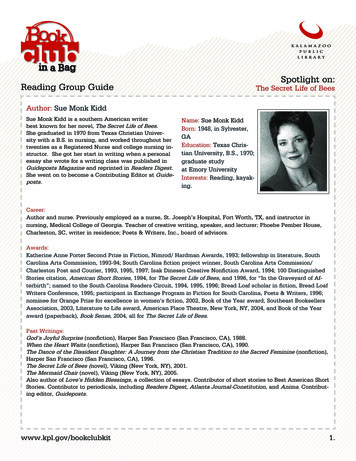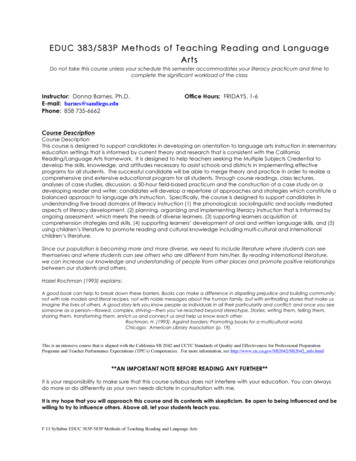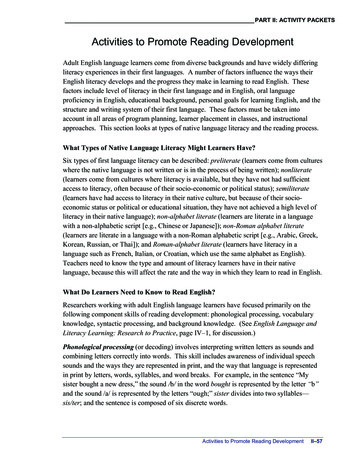
Transcription
Spotlight on:Reading Group GuideThe Secret Life of BeesAuthor: Sue Monk KiddSue Monk Kidd is a southern American writerbest known for her novel, The Secret Life of Bees.She graduated in 1970 from Texas Christian University with a B.S. in nursing, and worked throughout hertwenties as a Registered Nurse and college nursing instructor. She got her start in writing when a personalessay she wrote for a writing class was published inGuideposts Magazine and reprinted in Readers Digest.She went on to become a Contributing Editor at Guideposts.Name: Sue Monk KiddBorn: 1948, in Sylvester,GAEducation: Texas Christian University, B.S., 1970;graduate studyat Emory UniversityInterests: Reading, kayaking.Career:Author and nurse. Previously employed as a nurse, St. Joseph’s Hospital, Fort Worth, TX, and instructor innursing, Medical College of Georgia. Teacher of creative writing, speaker, and lecturer; Phoebe Pember House,Charleston, SC, writer in residence; Poets & Writers, Inc., board of advisors.Awards:Katherine Anne Porter Second Prize in Fiction, Nimrod/ Hardman Awards, 1993; fellowship in literature, SouthCarolina Arts Commission, 1993-94; South Carolina fiction project winner, South Carolina Arts Commission/Charleston Post and Courier, 1993, 1995, 1997; Isak Dinesen Creative Nonfiction Award, 1994; 100 DistinguishedStories citation, American Short Stories, 1994, for The Secret Life of Bees, and 1996, for “In the Graveyard of Afterbirth”; named to the South Carolina Readers Circuit, 1994, 1995, 1996; Bread Loaf scholar in fiction, Bread LoafWriters Conference, 1995; participant in Exchange Program in Fiction for South Carolina, Poets & Writers, 1996;nominee for Orange Prize for excellence in women’s fiction, 2002, Book of the Year award, Southeast BooksellersAssociation, 2003, Literature to Life award, American Place Theatre, New York, NY, 2004, and Book of the Yearaward (paperback), Book Sense, 2004, all for The Secret Life of Bees.Past Writings:God’s Joyful Surprise (nonfiction), Harper San Francisco (San Francisco, CA), 1988.When the Heart Waits (nonfiction), Harper San Francisco (San Francisco, CA), 1990.The Dance of the Dissident Daughter: A Journey from the Christian Tradition to the Sacred Feminine (nonfiction),Harper San Francisco (San Francisco, CA), 1996.The Secret Life of Bees (novel), Viking (New York, NY), 2001.The Mermaid Chair (novel), Viking (New York, NY), 2005.Also author of Love’s Hidden Blessings, a collection of essays. Contributor of short stories to Best American ShortStories. Contributor to periodicals, including Readers Digest, Atlanta Journal-Constitution, and Anima. Contributing editor, Guideposts.www.kpl.gov/bookclubkit .
Author: Sue Monk Kid (2)Media Adaptations:The Secret Life of Bees has been adapted for the stage and produced at the American Place Theater, New York,NY; and has been optioned for screen adaptation by Focus Films. Unabridged versions of The Secret Life of Beeshave been adapted for audiocassette and CD, read by Jenna Lamia, HighBridge Audio, 2002, and for audiocassette, read by Karen White, Books on Tape, 2002; The Mermaid Chair has also been adapted as an audiobook.Sidelights:Sue Monk Kidd became interested in writing when she was a child. “My desire to become a writer was born,”she explained in her biography on her Home Page, “while listening to my father ply us with tales about muleswho went through cafeteria lines and a petulant boy named Chewing Gum Bum.” She wrote throughout herchildhood, but at the age of sixteen stopped writing completely until long after she graduated from Texas Christian University with a nursing degree. “The only time I really doubted my career choice,” she recalled in herbiography, “was when my English professor said to me, and I quote, ‘For the love of God, why are you a nursingmajor? You are a born writer.’” Kidd went on to work as a nurse and later as a nursing instructor.In her thirties, Kidd nurtured her lifelong interest in spirituality with a serious study of Western religion andtheology before turning to psychology and mythology. It was during this period that she returned to writing andpublished essays that grew out of her spiritual journey. She described her first book, God’s Joyful Surprise, as “aspiritual memoir which chronicled my early experiences with contemplative Christian spirituality.” She followedthat book with When the Heart Waits, which portrays the psychological and spiritual transformation she laterexperienced. When her spiritual explorations took her into feminist theology in her forties, Kidd captured thatexperience in The Dance of the Dissident Daughter. “The book found a huge audience of women,” she recountedin her biography, “and their response to it was astonishingly passionate.”But even as she was gaining recognition for her feminist religious studies, Kidd still held on to her childhood lovefor stories. She seriously studied the craft of fiction in various courses and conferences before starting her firstnovel in 1997. Three years later, The Secret Life of Bees was sold for publication.Set in South Carolina in 1964, The Secret Life of Bees is the story of fourteen-year-old Lily, who has been raisedby her abusive father and their black servant, Rosaleen. When Lily was only four years old her mother was killed.Her father blames Lily for his wife’s death. Lily and Rosaleen run away from her abusive father and the police,who have beaten Rosaleen for trying to vote. Not knowing where to go, they head for Tiburon, South Carolina,the words on the back of the cross Lily’s mother wore. In Tiburon they find Black Madonna Honey, an apiary runby three black sisters—August, June, and May—who allow Lily and Rosaleen to stay with them. There Lily ishappy. She learns much about bees, and finds out what really happened to her mother. A writer for PublishersWeekly noted that the book “features a hive’s worth of appealing female characters, an offbeat plot and a lovelystyle.” In what he called a “sweeping debut novel” in his Library Journal review, David A. Berona pointed outthat “the stunning metaphors and realistic characters are so poignant that they will bring tears to your eyes.”Beth Kephart, reviewing the book for Book magazine, observed: “Goodness—what it is, what it looks like, whobestows it—is the frame within which this book is masterfully hung, the organizing principle behind this intimate, unpretentious, and unsentimental work.”The Mermaid Chair, Kidd’s follow-up to her successful first novel, tells the story of Jessie Sullivan, a middleaged housewife and part-time artist who is drawn back to her childhood home after receiving some disturbingnews about her estranged mother. Leaving behind her loyal, though slightly controlling, husband, Hugh, Jessieventures back to tiny Egret Island, located off the coast of South Carolina. Upon her return, Jessie finds that herextraordinarily devout mother, Nelle, has cut off her finger for reasons unknown. Jessie suspects her mother’sdescent into madness may have something to do with her father’s tragic death over thirty-three years ago, forwhich Jessie has always blamed herself. Her quest for answers leads Jessie to the local monastery where evenwww.kpl.gov/bookclubkit .
Author: Sue Monk Kidd (3)Sidelights: (Continued)more mysteries await her. Here she finds a strange chair fashioned with the image of a saint who was once amermaid, as well as a young monk, Brother Thomas, who is on the verge of taking his final vows. In him, Jessiefinds a passion she thought was lost and she begins to feel a reawakening of her emotions, her sensuality, andher artistic vision. The secrets of the past collide with the uncertainties of the present in what a writer for Publishers Weekly described as an “emotionally rich novel, full of sultry, magical descriptions of life in the South.”In her review for Entertainment Weekly, Jennifer Reese called this effort by Kidd “a goopy follow up” to her bestselling debut, The Secret Life of Bees. Conversely, while reviewing Kidd’s novel for Time, Lev Grossman pointedout that the author’s “writing is so smart and sharp, she gives new life to old midlife crises, and she draws connections from the feminine to the divine to the erotic that a lesser writer wouldn’t see, and might not have theguts to follow.”Further Readings:Periodicals:Book, January-February, 2002, Beth Kephart, “Sweet as Honey.”Booklist, December 1, 2001, Kristine Huntley, review of The Secret Life of Bees, p. 628; February 15, 2005, KristineHuntley, review of The Mermaid Chair, p. 1036.Book World, April 10, 2005, Donna Rifkind, review of The Mermaid Chair, p. 6.Entertainment Weekly, April 1, 2005, Jennifer Reese, review of The Mermaid Chair, p. 75.Kirkus Reviews, October 15, 2001, review of The Secret Life of Bees, p. 1447; February 1, 2005, review of The Mermaid Chair, p. 140.Library Journal, Henry Carrigan, Jr., review of The Dance of the Dissident Daughter: A Journey from the ChristianTradition to the Sacred Feminine, p. 100; December, 2001, David A. Berona, review of The Secret Life of Bees, p.173. ttLos Angeles Times, March 24, 2002, Susan Salter Reynolds, review of The Secret Life of Bees, p. R15.New York Times Book Review, March 31, 2002, review of The Secret Life of Bees, p. 17; May 22, 2005, Dana Kennedy, review of The Mermaid Chair, p. 24.Publishers Weekly, March 1, 1991, William Griffin, review of Love’s Hidden Blessings, p. 43; April 22, 1996,review of The Dance of the Dissident Daughter, p. 65; August 6, 2001, Lucinda Dyer, “Sue Monk Kid: The SecretLife of Bees, “p. 49; November 12, 2001, review of The Secret Life of Bees, p. 33; February 21, 2005, review of TheMermaid Chair, p. 155; March 28, 2005, Marcia Ford, “Sue Monk Kidd: Monk Kidd’s Monk,” p. S16; April 4, 2005,Bob Summer, “Sue Monk Kidd: Monk Kidd’s Monk,” p. 39.Time, April 4, 2005, Lev Grossman, “Sex and the Sacred: A Bittersweet Novel of Midlife Crisis and ForbiddenLove from the Author of The Secret Life of Bees,” p. 69.Washington Post, January 13, 2002, review of The Secret Life of Bees, p. T05.Online:Sue Monk Kidd Home Page, http:// www.suemonkkidd.com (August 12, 2005).*Contemporary Authors Online, Thomson Gale, 2005.www.kpl.gov/bookclubkit .
Reading Group GuideSpotlight on:The Secret Life of BeesAbout This Book:Set in the American South in 1964, the year of the Civil Rights Act and intensifying racial unrest, Sue Monk Kidd’sThe Secret Life of Bees is a powerful story of coming-of-age, of the ability of love to transform our lives, and theoften unacknowledged longing for the universal feminine divine. Addressing the wounds of loss, betrayal, andthe scarcity of love, Kidd demonstrates the power of women coming together to heal those wounds, to mothereach other and themselves, and to create a sanctuary of true family and home.Isolated on a South Carolina peach farm with a neglectful and harsh father, fourteen-year-old Lily Owens hasspent much of her life longing for her mother, Deborah, who died amid mysterious circumstances when Lily wasfour years old. To make matters worse, her father, T. Ray, tells Lily that she accidentally killed her mother.Lily is raised by Rosaleen, her proud and outspoken African-American nanny. When Rosaleen attempts to exercise her newly won right to vote, she is attacked by the three worst racists in town and is thrown into jail. Lily isdetermined to save Rosaleen and finally escape her own father as well. Seizing the moment, she springs Rosaleen from jail, and the two set out across South Carolina in search of a new life.Their destination is Tiburon, South Carolina—a town they know nothing about except that in a box of Lily’smother’s belongings there is a cryptic picture of a black Virgin Mary with the words “Tiburon, South Carolina”written on the back. There they are taken in by three black beekeeping sisters who worship the Black Madonna.It is here, surrounded by the strength of the Madonna, the hum of bees, and a circle of wise and colorful women,that Lily makes her passage to wholeness and a new life.Captured by the voice of this Southern adolescent, one becomes enveloped in the hot South Carolina summer andone of most tumultuous times the country has ever seen. A story of mothers lost and found, love, conviction, andforgiveness, The Secret Life of Bees boldly explores life’s wounds and reveals the deeper meaning of home andthe redemptive simplicity of “choosing what matters.”Discussion Questions:1. Were you surprised to learn that T. Ray used to be different, that once he truly loved Deborah? How do youthink Deborah’s leaving affected him? Did it shed any light on why T. Ray was so cruel and abusive to Lily?2. Had you ever heard of “kneeling on grits”? What qualities did Lily have that allowed her to survive, endure,and eventually thrive, despite T. Ray?3. Who is the queen bee in this story?4. Lily’s relationship to her dead mother was complex, ranging from guilt to idealization, to hatred, to acceptance.What happens to a daughter when she discovers her mother once abandoned her? Is Lily right—would peoplegenerally rather die than forgive? Was it harder for Lily to forgive her mother or herself?www.kpl.gov/bookclubkit .
Book: The Secret Life of BeesDiscussion Questions: (Continued)5. Lily grew up without her mother, but in the end she finds a house full of them. Have you ever had a motherfigure in your life who wasn’t your true mother? Have you ever had to leave home to find home?6. What compelled Rosaleen to spit on the three men’s shoes? What does it take for a person to stand up withconviction against brutalizing injustice? What did you like best about Rosaleen?7. Had you ever heard of the Black Madonna? What do you think of the story surrounding the Black Madonna inthe novel? How would the story be different if it had been a picture of a white Virgin Mary? Do you know womenwhose lives have been deepened or enriched by a connection to an empowering Divine Mother?8. Why is it important that women come together? What did you think of the “Calendar Sisters” and the Daughters of Mary? How did being in the company of this circle of females transform Lily?9. May built a wailing wall to help her come to terms with the pain she felt. Even though we don’t have May’scondition, do we also need “rituals,” like wailing walls, to help us deal with our grief and suffering?10. How would you describe Lily and Zach’s relationship? What drew them together? Did you root for them to betogether?11. Project into the future. Does Lily ever see her father again? Does she become a beekeeper? A writer? Whathappens to Rosaleen? What happens to Lily and Zach? Who would Zach be today?www.kpl.gov/bookclubkit .
Book: The Secret Life of BeesNoveList Reading Group Guide:Author:The Secret Life of Bees is Sue Monk Kidd’s first novel, yet she is no stranger to writing. Looking back on her earlylife, Kidd recalls “our most plentiful resource, next to family roots, was stories” (http://www.suemonkkidd.com/html/author.asp). Not surprisingly, then, one of her favorite pastimes as a child was writing tales in imitation ofthe authors who were most important to her—the Brontës, Emerson, and Thoreau. Despite her early fascinationwith writing, however, Kidd did not begin writing professionally until much later in her life. Instead, she attended Texas Christian University where she earned a degree in nursing.It was not until after her children were born that Kidd began writing professionally. After her thirtieth birthday,she began taking writing courses and accepted an editor’s position at Guideposts magazine. Most of her workwas in non-fiction, as she wrote brief inspirational pieces based on true stories. Her work in non-fiction continued with her first books—God’s Joyful Surprise (1988), When the Heart Waits (1990), and The Dance of the Dissident Daughter (1996).The subject matter of Kidd’s non-fiction work plays an important role in The Secret Life of Bees, which she beganwriting in 1997 after taking a creative writing class at Emory University. Both God’s Joyful Surprise and Whenthe Heart Waits chronicle Kidd’s own spiritual journey as she studied Benedictine, Jesuit, and Trappist monks.The notion of a spiritual community shows up in The Secret Life of Bees in the Daughters of Mary, a society ofwomen who provide spiritual nurturing and comfort to each other. Similarly, The Dance of the Dissident Daughterdetails Kidd’s experiences studying feminist theology, and the impact of that study can clearly be seen in TheSecret Life of Bees. The resulting mix of fiction with theology and philosophy garnered multiple awards for thenovel, including the 2004 Book Sense Book of the Year Award. In addition, the book was nominated for the prestigious Orange Prize in England.In her online journal, Sue Monk Kidd writes that although the characters and situations in her fiction have parallels with her own life, they ultimately are “shaped by the mystery of imagination, which is fed to us through astream of images, rising from the unconscious. The writer’s task is to keep the way open for it and pay al.asp). What results in her writing is a purely fictional world thatnevertheless is colored by Kidd’s own experiences. It is not surprising then that the novel on which she currentlyis working revolves around religion and spirituality, two subjects of great concern to her. The Mermaid Chair,which will be published by Viking, tells the story of a middle-aged woman who falls in love with a monk living ina monastery off the coast of South Carolina.Sue Monk Kidd currently lives with her husband in South Carolina.Summary:Lily Owens, a fourteen-year-old white girl, lives with her abusive father T. Ray in a small town in racially dividedSouth Carolina in the 1960s. She spends much of her time wondering about her mother Deborah, who died whenLily was only four. Lily’s earliest memories are of her mother’s death. All that she knows about it is that hermother died of a gunshot wound, and with some help from her father, Lily remembers that she herself was responsible for the death. One of the few mementos that Lily has is a picture that her mother kept of a black VirginMary with the words “Tiburon, S.C.” on the back. In the absence of a mother, Lily is taken care of by Rosaleen,her black nanny.www.kpl.gov/bookclubkit .
Book: The Secret Life of BeesNoveList Reading Group Guide: (Continued)When Rosaleen decides to exercise her new right to vote, she and Lily find themselves in deep trouble. Whenshe is antagonized by several white men, Rosaleen pours the contents of her tobacco spittoon across the topsof their shoes, and the police soon arrive to arrest her. Rosaleen is quickly moved to the local hospital to recoverfrom the beating she received at the hands of the white men. Although Lily is not arrested, she conceives aningenious plan to rescue Rosaleen. She fools the guard at the hospital, and she and Rosaleen escape and headstraight towards Tiburon.When they arrive in Tiburon, Rosaleen sends Lily inside the general store to buy tobacco for her. Inside, Lilynotices jars of honey, each of which has the same picture of the black Virgin that her mother had carried. Shelearns that a black woman named August Boatwright makes the honey at a farm on the outskirts of town whereshe lives with her sisters May and June. When Rosaleen and Lily show up on the doorstep, August takes themin without question. Lily soon learns, however, that the three sisters are rather odd. May is extremely sensitive,seeming to feel the pain of everyone around her. To help her deal with the pain, the sisters have built a versionof the Wailing Wall, and May writes down all of the pains that she feels and places them in cracks in the wall.Moreover, the sisters and some of the other local blacks participate in a ritual worshipping of Our Lady of Chains,a black statue of the Virgin Mary who, according to local legend, provided solace to August’s slave ancestors.Each year on Mary Day, they cover the statue in honey, a ritual to preserve the memory of Our Lady in theirhearts.August soon puts Lily to work in her honey business where Lily meets Zach, a young black man who aspires tobe a lawyer. The two of them soon begin to fall in love, although both recognize that because of racial conflicts,they cannot express this love in any way. One afternoon when she and Zach go into town, a young black boythrows a bottle at a white man. Uncertain as to which of the black teens threw the bottle, the police put them allin jail. When May finds out that Zach has been jailed, the pain is too much for her, and she commits suicide.In the aftermath of May’s suicide, Lily finally opens up to August about her mother. She learns that August hadbeen Deborah Fontanel’s nanny, caring for her until she married T. Ray. After her marriage, Deborah becamequite depressed, and she left T. Ray to return to be with August, leaving Lily with him. On the day that she died,Deborah had returned to get Lily to bring her back to August’s house. Upon learning all of this, Lily becomesquite angry. She only comes to terms with the fact that her mother had left her when T. Ray shows up. Angry atLily and ready to take her back home, T. Ray begins to confuse her with Deborah. Only at this point can Lily recognize that her father’s abusiveness stems partially from the death of her mother. The novel closes with T. Raydriving off after having told Lily that she had, in fact, killed her mother. Lily remains unsure whether to believehim or not. At this point in her life, however, it no longer matters to her, for she has learned from August andfrom Our Lady of Chains how to start over again.Questions:While answers are provided, there is no presumption that you have been given the last word. Readers bring theirown personalities to the books that they are examining. What is obvious and compelling to one reader may be invisible to the next. The questions that have been selected provide one reasonable access to the text; the answersare intended to give you examples of what a reflective reader might think. The variety of possible answers is oneof the reasons we find book discussions such a rewarding activity.What does August mean when she tells Lily that “everybody needs a God who looks like them” (p. 141)?www.kpl.gov/bookclubkit .
Book: The Secret Life of BeesNoveList Reading Group Guide: (Continued)When Lily asks August for an explanation of why she puts the Black Madonna on the labels of her honey jars,August replies that she does it because “’everybody needs a God who looks like them’” (p. 141). Specifically,August refers to the black community. For them, the black Madonna becomes a way to recognize that they canhave a divinity that reflects who they are and that addresses the concerns specific to their situations. As Augustputs it, “’when they looked at her, it occurred to them for the first time in their lives that what’s divine can comein dark skin’” (p. 140-141). Both historically and in the present, the black communities with which August wasfamiliar needed a black divinity in order to feel that some higher power was looking out for their own specificneeds.At a deeper level, however, August’s claim reflects her own profound understanding of the purpose of religion.Later in the novel, she tells Lily that the Black Madonna is something more than just a “magical being”; instead,she is “something inside of you” (p. 288). August implies that the statue of the Black Madonna (as well as herpicture on the honey jars) is simply a representation of what is inside. More than just a black divinity, the Madonna represents the ability of all individuals to find wholeness within themselves. For the black community, itis important that the Madonna is black. She is a “God who looks like them.” This does not make her unimportantto a fourteen-year-old white girl, however; it just changes what she sees in the Madonna. Lily, rather than seeinga black divinity, sees a mothering divinity, and she finds a little bit of herself in the Madonna just as the blackcommunity does.What does Lily’s relationship with the three sisters and the Daughters of Mary suggest about racial identity?The Secret Life of Bees is set in the early 1960s, and as such, questions of racial identity and racial politics playa prominent role in the novel. The conflict begins when Rosaleen tries to register to vote, and from that point forward, the novel depicts conflict between whites and blacks. Lily, a white girl who lives with three black sistersfor most of the novel, becomes a key figure in understanding how the novel depicts the relationship between thetwo different communities.At the level of the individual, the novel suggests that racial barriers can be overcome completely. Lily liveshappily with August, June, and May, and although she does consider the question of her own whiteness, shelearns that she can be a part of their lives in such a way that race does not matter. The clearest example of thisoccurs during one of the meetings of the Daughters of Mary after May’s death. The black women jokingly tell ofwhite people’s funerals, and one even tells a tale of how the whites have converted a bank into a funeral parlor,complete with a drive-through window for viewing. Lily is shocked, and asks August to make sure they don’tput May in the drive-through window. When Sugar-Girl, one of the black women, overhears Lily’s comment, sheexclaims “’The drive-by window is at the white people’s funeral home. They’re the only ones with enough moneyto fix up something that ridiculous’” (p. 208). Sugar Girl’s words fill Lily with happiness, for “not one person inthe room said, Sugar Girl, really, talking about white people like that and we have a white person present. Theydidn’t even think of me being different” (p. 209). Being completely accepted like this deeply changes Lily. Sheconcludes from it that her old way of thinking that blacks and whites should get along together would be betterreplaced with the goal of “everybody being colorless together” (p. 209). At the level of individuals, Lily achievesthis goal, for her relationship with the three sisters and the Daughters of Mary is one in which race seems to playno factor at all.What is the significance of Lily’s relationship with Zach?www.kpl.gov/bookclubkit .
Book: The Secret Life of BeesNoveList Reading Group Guide: (Continued)If Lily’s relationship with the black women suggests that individuals can overcome their own racial prejudices,her relationship with Zach raises troubling questions about how blacks and whites get along at the societallevel. Initially, Lily’s friendship and love for Zach seem to be part of her own journey in understanding how racism has affected her. When she first meets Zach, Lily notes that “if he was shocked over me being white, I wasshocked over him being handsome” (p. 116). Zach is unprepared to see a white girl living with the black womenand Lily is unprepared to find a black boy physically attractive. The implications of their different races becomeeven more troubling to Lily when she begins to fall in love with Zach. She thinks to herself “it was foolish tothink some things were beyond happening, even being attracted to Negroes. I’d honestly thought such a thingcouldn’t happen, the way water could not run uphill or salt could not taste sweet” (p. 125). Lily’s thoughts herereveal that despite her best efforts to love August, May, June, and Rosaleen, remnants of racism remain in her.One of the most troubling aspects of the novel, however, is that once Lily has overcome these last bits of racism,her relationship with Zach still remains unresolved. As events unfold in the novel, the two finally come to a placewhere they can admit that they love each other. Yet immediately after their first kiss, Zach tells Lily “’We can’tbe together now, Lily, but one day, after I’ve gone away and become somebody, I’m gonna find you, and we’llbe together then’” (p. 231). Zach’s words echo things that he has said earlier in the novel—that whites wouldkill a black boy for loving a white girl and that Lily needs to keep her distance from him. Although racial identityis irrelevant to Lily and Zach as individuals, the novel suggests that the deeper racism in society forces them torecognize that, for the moment at least, their love is impossible. Lily’s relationship with Zach thus offers a different perspective on racial conflict than does her relationship with the black women. Taken together, these different relationships ultimately suggest that for the races to live together peacefully, change must occur not only atthe individual level, but also within society itself.What does the novel suggest about the importance of stories?Fairly early in the novel, Lily comments “one thing I was starting to understand was that August loved to tell agood story” (p. 107). This theme of story-telling continues to appear throughout the remainder of the book, andstories come to have two primary purposes. First, they allow the tellers to explain their worlds in a way thatmakes sense to them. Second, they become a way of recording things that matter.One of the most important aspects of stories in The Secret Life of Bees is that they are rarely (if ever) “true” inthe ordinary sense of the word. One of the stories that August tells Lily was about the time that August’s mother, Big Mama, went out to the beehives on Christmas Eve and heard the bees singing the words of the Christmasstory from the gospel of Luke. When Lily hears this story, she responds with skepticism, asking August if she believes that it really happened or not. August’s reply demonstrates how stories can be used to explain the worldnot as it is, but as it should be: “’Well, yes and no,’ she said. ‘Some things happen in a literal way, Lily. And thenother things, like this one, happen in a not-literal way, but they still
The Secret Life of Bees About This Book: Set in the American South in 964, the year of the Civil Rights Act and intensifying racial unrest, Sue Monk Kidd's The Secret Life of Bees is a powerful story of coming-of-age, of the ability of love to transform our lives, and the often unacknowledged longing for the universal feminine divine.











